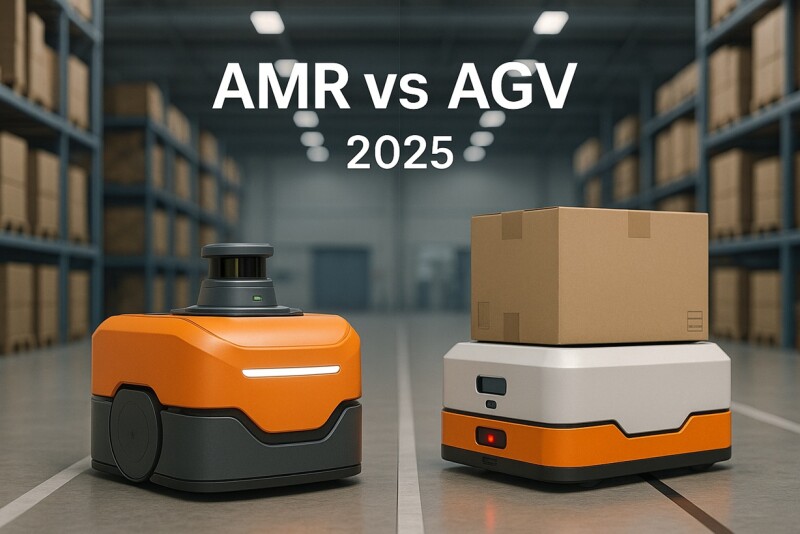AMR vs AGV in 2025: What’s the Real Difference for Smart Intralogistics?
In 2025, the debate between AMRs (Autonomous Mobile Robots) and AGVs (Automated Guided Vehicles) is no longer about cost — it’s about intelligence, flexibility, and scalability. While both move goods across factories and warehouses, their design philosophies and technologies differ dramatically. Understanding these differences helps logistics managers choose the right system for Industry 4.0 environments.
1. Navigation: Fixed Paths vs. Dynamic Autonomy
Traditional AGVs follow predefined paths using magnetic tape, reflectors, or embedded wires. They stop when obstacles appear and require manual intervention to resume. AMRs, by contrast, use LIDAR, vision systems, and SLAM algorithms to navigate dynamically.
When combined with AI-based mapping and localization, AMRs can plan new routes in real time — a critical advantage for variable warehouse layouts. This flexibility makes them ideal for mixed-traffic zones with humans, forklifts, and other robots.
2. Infrastructure Requirements
AGVs depend heavily on fixed infrastructure: magnetic lines, QR codes, or reflective markers. AMRs require none of this, relying instead on onboard perception and digital maps. This drastically reduces installation time and cost, while also improving scalability.
Companies can start small — a single AMR pilot — and scale to a fleet without tearing up the floor. This modular approach aligns perfectly with the Cobot Cells That Scale philosophy already transforming production environments.
3. Intelligence and Coordination
AMRs are essentially mobile computers equipped with CPUs, GPUs, and AI chips. Fleet management software connects them to WMS and ERP systems, allowing global optimization of routes and battery usage. Modern platforms even integrate AI fleet coordination for real-time dynamic task assignment.
AGVs, on the other hand, often rely on centralized traffic control and have limited onboard decision-making. While predictable and safe, they can’t react autonomously to unexpected obstacles or changes.
4. Safety and Compliance
Both AMRs and AGVs must comply with ISO 3691-4, which defines safety requirements for driverless vehicles. However, AMRs go further by integrating vision systems, 3D cameras, and AI-based obstacle classification — allowing intelligent slowdown, rerouting, and predictive collision avoidance.
For deeper insight into safe navigation design, see Warehouse Safety for AMRs: Sensors, Vision, and AI and compare with Cobot Safety Methodologies used in manufacturing environments.
5. ROI and Scalability
Although AMRs typically cost more upfront, their total cost of ownership (TCO) is often lower due to reduced installation effort and higher uptime. With no floor infrastructure and autonomous rerouting, AMRs adapt to layout changes instantly — a key ROI driver in dynamic facilities.
For a quantitative view, see Intralogistics Automation ROI: Calculating the Payback of AMRs. You’ll find that payback periods as short as 18 months are now typical in multi-shift operations.
6. Integration with Digital Twins and Edge AI
Many AMR deployments now integrate with digital twins to simulate warehouse flow before deployment. Edge AI systems analyze camera feeds locally for faster decision-making — similar to architectures used in Edge AI in the Factory.
This distributed intelligence reduces latency, improves safety, and supports predictive maintenance of both robots and facility equipment.
Summary Table: AMR vs. AGV at a Glance
| Feature | AGV | AMR |
|---|---|---|
| Navigation | Fixed path (tape, QR) | Dynamic (LIDAR, SLAM) |
| Infrastructure | High (guidance lines) | Low (self-mapping) |
| Safety | Basic obstacle stop | AI-based obstacle avoidance |
| Fleet Coordination | Centralized | Distributed, AI-driven |
| Scalability | Moderate | High, modular |
Related Articles
- How AI Optimizes AMR Fleet Management
- Warehouse Safety for AMRs: Sensors, Vision, and AI
- Intralogistics Automation ROI: Calculating the Payback of AMRs
- From Simulation to Deployment: How to Test AMR Routes
- Digital Twins for Industrial Automation: How to Start Small and Scale Fast
- Edge AI in the Factory: How Smart Devices Bring AI Closer to Production
- Cobot Cells That Scale: Modular Fencing, Light Curtains, and Safe Sensors
Quick Q&A
Q: Are AMRs replacing AGVs completely?
A: Not yet. AGVs still dominate highly structured, repetitive processes, but AMRs are rapidly expanding in dynamic environments.
Q: Can AMRs and AGVs coexist in one facility?
A: Yes. With proper fleet management software, both systems can share the same WMS and operate seamlessly.
Q: What’s the next evolution after AMRs?
A: Expect to see fully autonomous intralogistics ecosystems, where AMRs, conveyors, and cobots collaborate under unified AI fleet coordination.
Conclusion
AMRs represent the next step in intralogistics evolution — intelligent, adaptive, and safe. While AGVs still have their place in structured operations, the shift toward flexible, data-driven factories makes AMRs the clear choice for the future. By combining AI, edge computing, and digital twins, companies can build scalable systems that deliver both productivity and resilience.









































Interested? Submit your enquiry using the form below:
Only available for registered users. Sign In to your account or register here.